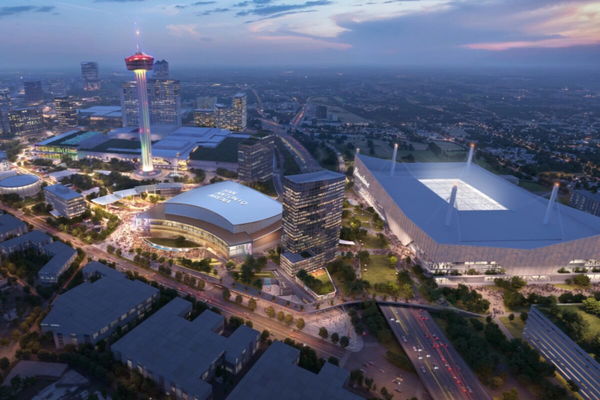
Imago
imagn

Imago
imagn
It started as a quiet idea under the codename “Project Marvel” and is now nearing realization. A brand-new Spurs Arena could soon become a reality. City records indicate that discussions about the downtown Bexar area began as early as 2023, with a proposal for a 17,000 to 18,500-seat arena designed to be ready for the 2032 NBA season. The city would own the arena and lease it to the Spurs.
Watch What’s Trending Now!
Consultants were brought in to assess how a central arena could revitalize the Hemisfair area. On August 21, 2025, the San Antonio City Council approved a non-binding term sheet with the Spurs, setting the stage for a public vote and outlining a plan based on shared investment from the team, the city, and Bexar County. And the results are in.
ADVERTISEMENT
What was the outcome of the Bexar County vote on the Spurs’ Arena?
Bexar County voters narrowly approved both measures tied to funding a new downtown arena for the San Antonio Spurs.
The proposal was already a polarizing topic for the administration. There were two types of propositions introduced by the Spurs side.
Top Stories
Did NBA Fine Derrick White and Grady Dick for Exchanging Jerseys? Fact Checking Viral News

LeBron James & JJ Redick Helpless As NBA Ignores Lakers Plea Despite 5 Punishments

Luka Doncic Injury Update: Latest on the Lakers Star and Expected Return Timeline

Cameron Brink Announces Personal Decision Ahead of Unrivaled Debut With Paige Bueckers

Warriors Fans Erupt After Draymond Green Gets Ejected During Game vs Suns

To put it simply, Proposition A and Proposition B were the two ballot measures that determined how San Antonio and Bexar County would allocate their local venue tax funds.
ADVERTISEMENT
Proposition A focused on upgrading what the city already owns, like the Frost Bank Center. This is where the Spurs currently play their games.
And also the Freeman Coliseum, plus funding a new year-round rodeo facility. Proposition A passed with 55.91% of the vote in favor and 44.09% against.
ADVERTISEMENT
Proposition B, on the other hand, directs $311 million from that same venue tax toward building a brand-new downtown arena on the old Institute of Texan Cultures site.
This was the measure that the Spurs strongly supported. Their argument? It would anchor a vibrant new district for sports, concerts, and community events. Proposition B had a margin of 52.14% in favor, compared to 47.86% against.
Together, the two propositions unlock the first major piece of financing for the Project Marvel. What is it? It comprises of a sweeping downtown sports and entertainment district centered on the Spurs’ future home in the Hemisfair area.
ADVERTISEMENT
Roughly half of San Antonio’s share of the $1.1 billion arena funding will come from a special state-approved tool. It is known as a Project Finance Zone, or PFZ.
In simple terms, the city can use part of the state sales tax revenue generated by hotels near the main arena. This will help fund large public projects, such as arenas or convention centers.
Instead of raising new taxes, the city captures the additional hotel-related tax revenue generated by future growth around the project.
ADVERTISEMENT
Here is how it works – once the state designates the PFZ, it draws a three-mile circle around the new arena site.
In that area, over the next 30 years, any increase in hotel occupancy or sales generated will be set aside to repay the bonds that helped finance the arena. It is essentially a reinvestment model. The more the district thrives, the faster the project’s public portion pays for itself.
And for this, the city’s share accounts to $311 million in venue taxes toward the new multipurpose arena.
ADVERTISEMENT
The official plan to use public funds for the construction of the arena is a multi-layered idea. But it is rather functional. Let’s take a look.
How is the $311 million integrated into the full Arena funding plan?
The short answer is that the new downtown arena is being funded through a three-part financial plan. Bexar County will contribute up to $311 million, the City of San Antonio will provide approximately $489 million, and the Spurs will invest at least $500 million- ensuring they cover any cost overruns. Together, these contributions aim to fund an arena valued at roughly $1.3 to $1.4 billion.
ADVERTISEMENT
Here’s how the funding works in practice. Bexar County’s $311 million comes from venue taxes. The city’s $489 million is sourced from reinvesting existing tourism-related taxes. The Spurs’ $500 million pledge serves as the private investment needed to secure lenders and developers for the project.
There is public money is involved. The term’ related agreements’ encompasses several safeguards and city commitments. It is meant to limit risk.
For example, the Spurs agreed to a 30-year non-relocation pledge. Why? to fund a community benefits package. This includes money for local programs, discounted tickets, and contracting goals.
ADVERTISEMENT
What is the planned location and vision for the new downtown arena?
The San Antonio Spurs’ new arena is planned for the Hemisfair district. A historic stretch in the heart of the same downtown that once hosted the 1968 World’s Fair.
The city leaders believe it’s the perfect spot to connect the team’s legacy with San Antonio’s future. The Spurs currently play at the Frost Bank Center.
This is a 19,000-seat venue located on the city’s East Side, which opened in 2002. This is two decades of championship basketball. But the team’s lease there expires in 2032.

Imago
Project Marvel Rendering
Reports of a new downtown sports and entertainment district first surfaced in July 2023, when city officials began referring to the project internally as Project Marvel. The idea is clear. They want something bigger and better.
Spurs chairman Peter J. Holt captured that vision best on election night. “We love this city, we love this county, and the county and the city love us back,” he told reporters.
“We’re ready to do something really special that’s going to help the Spurs, it’s going to help the rodeo, it’s going to help all sectors of the community and it’s going to be right in the heart of our city. This is something we deserve. Our fans deserve it. Our community deserves it. We’re going to believe and execute big things.” It marks a return to the city’s roots.
The city will not only own the arena but also lease it to the Spurs for an initial annual rent of $4 million. This will then rise by 2% each year afterwards.
The deal overall will help keep the team from leaving San Antonio for another city. So the city gives back to its beloved sport. The team will also invest an extra $2.5 million per year, totalling up to $75 million for the community benefit agreement. Essentially, to rebuild and repair wherever and whenever it is needed.
Now, what makes this deal different is the number of offers pouring in. Compared to other teams in the game, the Spurs are putting in extra bills.
Owner Peter J. Holt said covering half of the arena’s cost was almost unheard of. This, in addition to all the other investments the team is making, is a significant development.
What economic and community benefits are anticipated?
The area is not being viewed solely as a basketball venue. They are selling it as an engine for downtown growth. Any venue plan will project thousands of construction jobs. This $1.3 billion project is expected to achieve the same results over the next several years.
Not only that, local officials project that the Hemisfair development is bound to draw millions of additional visitors to downtown each year. Naturally boosting hotel stays, restaurants, and small businesses.
The arena’s lease model is similar to deals used in places like Sacramento and Milwaukee. In essence, it is designed to ensure the project generates recurring local revenue instead of becoming a long-term taxpayer burden.
As mentioned earlier, beyond jobs and tourism, the arena plan includes community benefit agreements (CBA). The Spurs’ pledge to contribute up to $75 million over 30 years will be directly allocated through city funds.
These are funds the city can use for education, workforce programs, housing, or local arts initiatives. It’s a flexible pool and a social upliftment scheme in a way, to make sure the arena’s benefits reach its own people.
This type of partnership is what the city leaders describe as a “looping economy,” basically where the public assets help pay for themselves over time. Still, not everyone is convinced.
Who opposed the San Antonio Spurs’ new arena and what were their main concerns?
Opposition to the Spurs’ new downtown arena came from within. Mayor Gina Ortiz Jones called for deeper financial analysis, demanding better quality for a clearer picture of the city’s contribution.
“This is a generational investment, and regardless of the outcome, I look forward to making sure that we’ve got a win-win for San Antonio,” Jones said on Tuesday night.
The next major opposition the Spurs face is primarily from the COPS/Metro Alliance and the No Project Marvel coalition. Some local activists also questioned the use of public money for a private sports venue.
They argued that funds from venue taxes should be spent directly on the public, such as on housing and transportation.
“To me this says this is not a mandate,” said Beverly McClure of COPS/Metro Alliance, on Texas Public Radio. “The community needs to be involved, and that’s one of the things that we will ensure, and we’ll be at the table.”
Critics also noted that the current term sheet is non-binding, urging more transparency and community oversight before final approval. “We are going to continue to demand transparency. We are going to continue to advocate so that community voices can be heard. There’s still a non-binding term sheet, and there are going to be a lot of details that will need to be worked out.” McClure added.
Spurs chairman Peter J. Holt insists that their aim is the opposite. The team’s private share covers roughly half of the total arena cost. This can be considered a proof of good faith.
“This commitment shows our belief in the city, the county and having a fruitful partnership that benefits all,” Holt said during an August commissioners court meeting.
What are the next steps now that the vote has passed?
The Spurs have reached this stage of final public approval after months, if not years, of legal work- work that continues today. The project’s completion timeline remains uncertain and has not yet been finalized.
For now, the team will remain at its current home, the Frost Bank Center on the east side, until 2032. This venue was also approved by voters in 1999 under a similar tax system.
Interestingly, at that time, the Spurs, along with city and county leaders, had promised to revitalize the area. However, that promise ultimately went unfulfilled.
But this time, the local voters may have an upper hand. They have approved the funding measures, but the San Antonio Spurs and city officials have to finalize a 30-year non-relocation agreement.
This commitment from the team may help solidify the trust between all the entities involved.
With that commitment in place, the next step is to transition from the non-binding term sheet to a binding project agreement. The city may now begin issuing bonds, soliciting detailed design and construction plans.
As for the Spurs, they will line up private development partners tied to the surrounding sports and entertainment district.
Yet, at the same time, the broader vision for what will become the Project Marvel is starting to take form. The plan includes development around the arena for mixed-use purposes.
It will feature retail spaces, hotels, public plazas, and improved pedestrian connections to the convention center and River Walk. Together, these fresh steps mark the beginning of a multi-year, decades-long process aimed at turning the arena into a successful downtown revival.
ADVERTISEMENT
ADVERTISEMENT
ADVERTISEMENT

